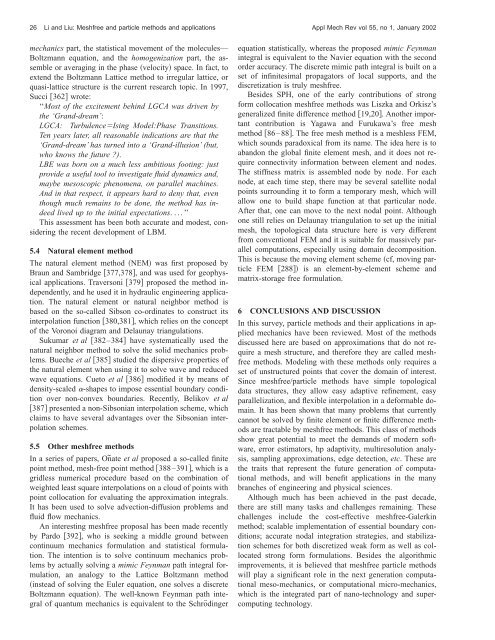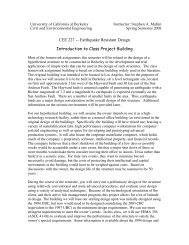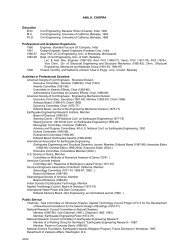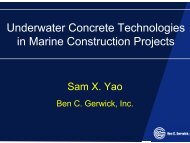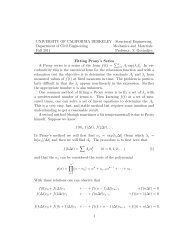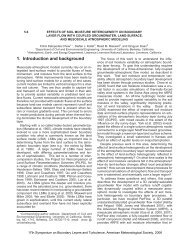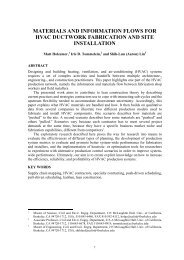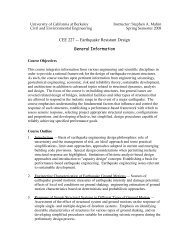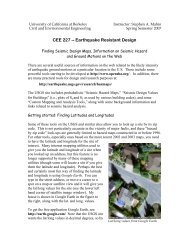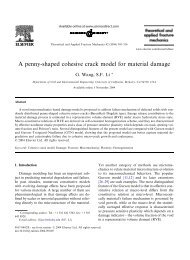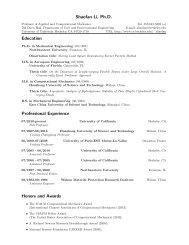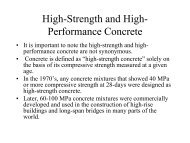Meshfree and particle methods and their applications - TAM ...
Meshfree and particle methods and their applications - TAM ...
Meshfree and particle methods and their applications - TAM ...
Create successful ePaper yourself
Turn your PDF publications into a flip-book with our unique Google optimized e-Paper software.
26 Li <strong>and</strong> Liu: <strong>Meshfree</strong> <strong>and</strong> <strong>particle</strong> <strong>methods</strong> <strong>and</strong> <strong>applications</strong> Appl Mech Rev vol 55, no 1, January 2002<br />
mechanics part, the statistical movement of the molecules—<br />
Boltzmann equation, <strong>and</strong> the homogenization part, the assemble<br />
or averaging in the phase velocity space. In fact, to<br />
extend the Boltzmann Lattice method to irregular lattice, or<br />
quasi-lattice structure is the current research topic. In 1997,<br />
Succi 362 wrote:<br />
‘‘Most of the excitement behind LGCA was driven by<br />
the ‘Gr<strong>and</strong>-dream’:<br />
LGCA: TurbulenceIsing Model:Phase Transitions.<br />
Ten years later, all reasonable indications are that the<br />
‘Gr<strong>and</strong>-dream’ has turned into a ‘Gr<strong>and</strong>-illusion’ (but,<br />
who knows the future ).<br />
LBE was born on a much less ambitious footing: just<br />
provide a useful tool to investigate fluid dynamics <strong>and</strong>,<br />
maybe mesoscopic phenomena, on parallel machines.<br />
And in that respect, it appears hard to deny that, even<br />
though much remains to be done, the method has indeed<br />
lived up to the initial expectations....’’<br />
This assessment has been both accurate <strong>and</strong> modest, considering<br />
the recent development of LBM.<br />
5.4 Natural element method<br />
The natural element method NEM was first proposed by<br />
Braun <strong>and</strong> Sambridge 377,378, <strong>and</strong> was used for geophysical<br />
<strong>applications</strong>. Traversoni 379 proposed the method independently,<br />
<strong>and</strong> he used it in hydraulic engineering application.<br />
The natural element or natural neighbor method is<br />
based on the so-called Sibson co-ordinates to construct its<br />
interpolation function 380,381, which relies on the concept<br />
of the Voronoi diagram <strong>and</strong> Delaunay triangulations.<br />
Sukumar et al 382–384 have systematically used the<br />
natural neighbor method to solve the solid mechanics problems.<br />
Bueche et al 385 studied the dispersive properties of<br />
the natural element when using it to solve wave <strong>and</strong> reduced<br />
wave equations. Cueto et al 386 modified it by means of<br />
density-scaled -shapes to impose essential boundary condition<br />
over non-convex boundaries. Recently, Belikov et al<br />
387 presented a non-Sibsonian interpolation scheme, which<br />
claims to have several advantages over the Sibsonian interpolation<br />
schemes.<br />
5.5 Other meshfree <strong>methods</strong><br />
In a series of papers, Oñate et al proposed a so-called finite<br />
point method, mesh-free point method 388–391, which is a<br />
gridless numerical procedure based on the combination of<br />
weighted least square interpolations on a cloud of points with<br />
point collocation for evaluating the approximation integrals.<br />
It has been used to solve advection-diffusion problems <strong>and</strong><br />
fluid flow mechanics.<br />
An interesting meshfree proposal has been made recently<br />
by Pardo 392, who is seeking a middle ground between<br />
continuum mechanics formulation <strong>and</strong> statistical formulation.<br />
The intention is to solve continuum mechanics problems<br />
by actually solving a mimic Feynman path integral formulation,<br />
an analogy to the Lattice Boltzmann method<br />
instead of solving the Euler equation, one solves a discrete<br />
Boltzmann equation. The well-known Feynman path integral<br />
of quantum mechanics is equivalent to the Schrödinger<br />
equation statistically, whereas the proposed mimic Feynman<br />
integral is equivalent to the Navier equation with the second<br />
order accuracy. The discrete mimic path integral is built on a<br />
set of infinitesimal propagators of local supports, <strong>and</strong> the<br />
discretization is truly meshfree.<br />
Besides SPH, one of the early contributions of strong<br />
form collocation meshfree <strong>methods</strong> was Liszka <strong>and</strong> Orkisz’s<br />
generalized finite difference method 19,20. Another important<br />
contribution is Yagawa <strong>and</strong> Furukawa’s free mesh<br />
method 86–88. The free mesh method is a meshless FEM,<br />
which sounds paradoxical from its name. The idea here is to<br />
ab<strong>and</strong>on the global finite element mesh, <strong>and</strong> it does not require<br />
connectivity information between element <strong>and</strong> nodes.<br />
The stiffness matrix is assembled node by node. For each<br />
node, at each time step, there may be several satellite nodal<br />
points surrounding it to form a temporary mesh, which will<br />
allow one to build shape function at that particular node.<br />
After that, one can move to the next nodal point. Although<br />
one still relies on Delaunay triangulation to set up the initial<br />
mesh, the topological data structure here is very different<br />
from conventional FEM <strong>and</strong> it is suitable for massively parallel<br />
computations, especially using domain decomposition.<br />
This is because the moving element scheme cf, moving <strong>particle</strong><br />
FEM 288 is an element-by-element scheme <strong>and</strong><br />
matrix-storage free formulation.<br />
6 CONCLUSIONS AND DISCUSSION<br />
In this survey, <strong>particle</strong> <strong>methods</strong> <strong>and</strong> <strong>their</strong> <strong>applications</strong> in applied<br />
mechanics have been reviewed. Most of the <strong>methods</strong><br />
discussed here are based on approximations that do not require<br />
a mesh structure, <strong>and</strong> therefore they are called meshfree<br />
<strong>methods</strong>. Modeling with these <strong>methods</strong> only requires a<br />
set of unstructured points that cover the domain of interest.<br />
Since meshfree/<strong>particle</strong> <strong>methods</strong> have simple topological<br />
data structures, they allow easy adaptive refinement, easy<br />
parallelization, <strong>and</strong> flexible interpolation in a deformable domain.<br />
It has been shown that many problems that currently<br />
cannot be solved by finite element or finite difference <strong>methods</strong><br />
are tractable by meshfree <strong>methods</strong>. This class of <strong>methods</strong><br />
show great potential to meet the dem<strong>and</strong>s of modern software,<br />
error estimators, hp adaptivity, multiresolution analysis,<br />
sampling approximations, edge detection, etc. These are<br />
the traits that represent the future generation of computational<br />
<strong>methods</strong>, <strong>and</strong> will benefit <strong>applications</strong> in the many<br />
branches of engineering <strong>and</strong> physical sciences.<br />
Although much has been achieved in the past decade,<br />
there are still many tasks <strong>and</strong> challenges remaining. These<br />
challenges include the cost-effective meshfree-Galerkin<br />
method; scalable implementation of essential boundary conditions;<br />
accurate nodal integration strategies, <strong>and</strong> stabilization<br />
schemes for both discretized weak form as well as collocated<br />
strong form formulations. Besides the algorithmic<br />
improvements, it is believed that meshfree <strong>particle</strong> <strong>methods</strong><br />
will play a significant role in the next generation computational<br />
meso-mechanics, or computational micro-mechanics,<br />
which is the integrated part of nano-technology <strong>and</strong> supercomputing<br />
technology.


